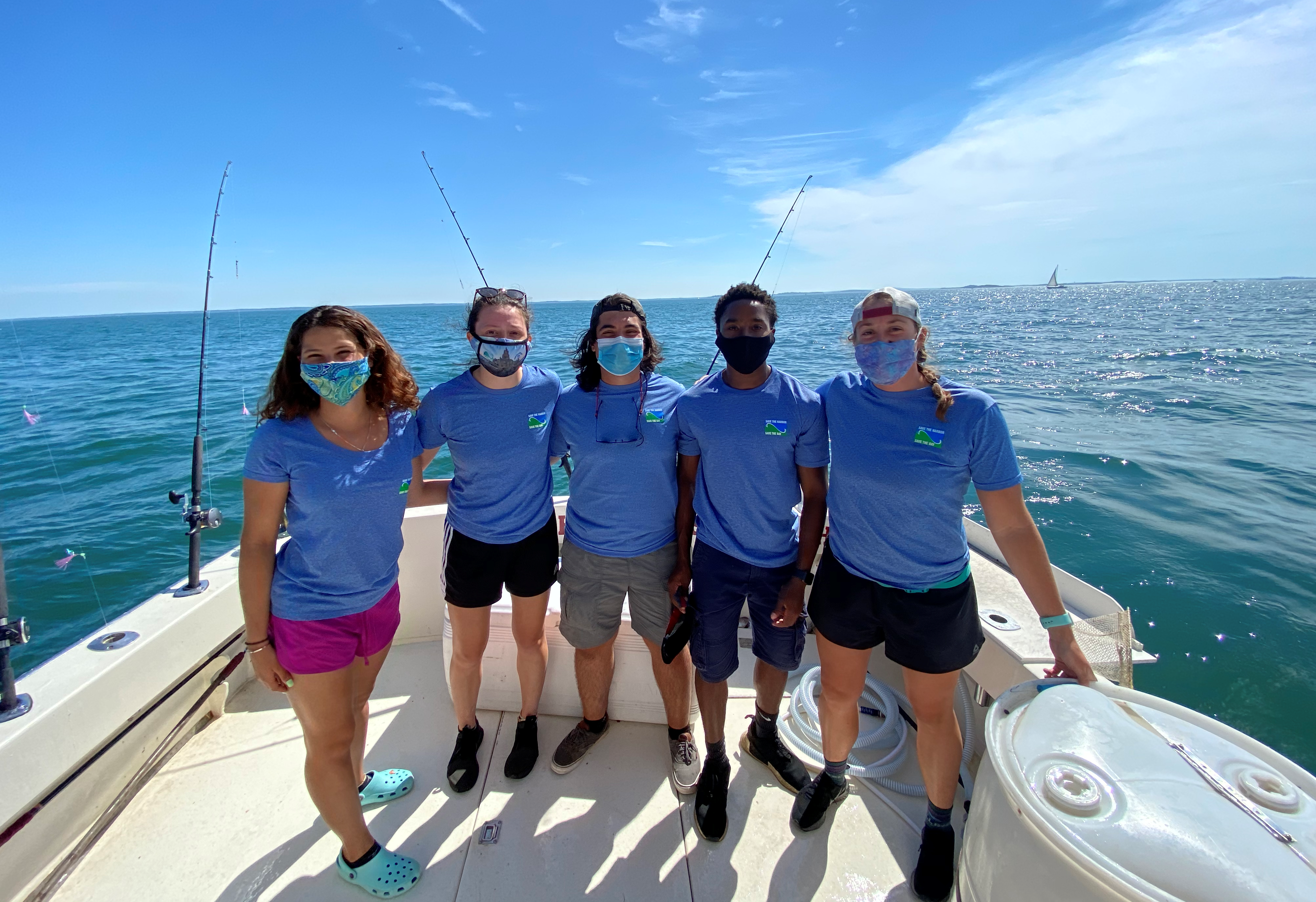
Haddock, History and Humpbacks: A Day in Stellwagen Bank
By: Michael Dello Russo, Grace Burns, Roy Thompson, Vanessa DoVale & Kristen Barry, Save the Bay/Save the Harbor Summer Youth Staffers
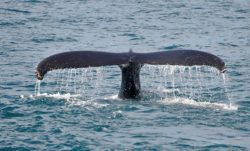
On Sunday July 26th, five Save the Harbor/Save the Bay summer youth staffers got the opportunity to go on a ten-hour marine wildlife and fishing cruise off the coast of Massachusetts. A swift push from the dock was all we needed to begin the hour and a half journey to the Stellwagen Bank National Marine Sanctuary. Captain Mike Delzingo and First Mate Bradley of Fishbucket Sportfishing Boston invited Kristen, Vanessa, Grace, Roy, and Michael to explore the bank with fishing and wildlife observation along the way. We were joined by Krill Carson of New England Coastal Wildlife Alliance (NECWA) who shared her in depth knowledge about the marine animals that inhabit the waters of Stellwagen Bank.
Prior to the trip, the collective offshore experience of the Save the Harbor team aboard the Fishbucket could be chalked up to a few whale watches, fishing charters, and Provincetown Ferries. Our work at Save the Harbor is often located in and around Boston’s Inner Harbor and the Boston Harbor Islands, so needless to say we were excited to get on our way and see what Massachusetts’s offshore waters had to offer. Before we departed, and on our trip out to Stellwagen, Krill and Captain Mike provided us some great resources from NOAA, notebooks for us to record our sightings and catches in, as well as NECWA commonly encountered species guides so we could further familiarize ourselves with the history of the Sanctuary as well as the animals we may catch a glimpse of.
Stellwagen Bank is a large underwater feature that rises out of the ocean floor in Massachusetts Bay. Water depth goes from 300’ to 100’ incredibly quickly which causes an upwelling of currents that brings nutrients to the shallower waters on the bank. This creates an excellent habitat for organisms ranging from phytoplankton and invertebrates to the whales that come to feed on them. Like many of the geologic formations in New England, Stellwagen Bank was likely the product of glacial activity some 20,000 years ago. As ice sheets receded, glacial till was deposited and formed Cape Cod and Stellwagen Bank. Based on the fossils found on the bank, such as mammoth teeth, Stellwagen must have been above sea level for some time before being covered by the Atlantic Ocean. Thousands of years after its formation, Stellwagen Bank and the other banks in the area served as important fishing grounds that helped to build the prolific seafood industries that are synonymous with places like Gloucester. Captain Henry S. Stellwagen is credited with discovering the bank. Even though fishermen were aware of shallow areas, the bank was not officially mapped until Captain Stellwagen’s work. Luckily for us, Stellwagen Bank was designated as a National Marine Sanctuary in 1992. This allowed for fishing and shipping to continue in the area, but it prevented the mining of sand and gravel from the bank, protecting the essential marine habitat there. Krill likened it to a National Park, but offshore.
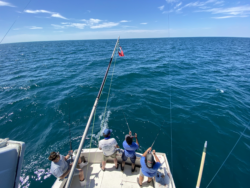
Photo Credit: Kristen Barry
After an hour and a half of cruising out of Boston, we reached the Northwest Corner of the bank where we made our first stop to fish. We were after groundfish. Groundfish are a group of fish that spend most of their time near the bottom, hence the name, with the most familiar species being cod and haddock. Fishing for these species is intrinsically linked with New England. The pilgrims headed for Plymouth with the goal of fishing cod, and Native Americans reaped the benefits of the sea long before that. In author Mark Kurlansky’s book, Cod, the importance of groundfishing for New Englanders, both economically and culturally, is heavily stressed. Cod was so essential to New England, especially Massachusetts, that a wooden “Sacred Cod” sculpture has been hanging in Massachusetts legislative buildings for over 200 years. We felt proud to continue this tradition of fishing the Northwest Atlantic banks, although we found none. Cod, which was once so plentiful that early European explorer Bartholomew Gosnold states his “ship… was constantly ‘pestered’ by these fish” off the coast of Cape Cod (Kurlansky, 65), has now been reduced to very low numbers. If we had caught any cod, they would have been released promptly to help rebuild their stock.
Our rods were set up with tandem rigs consisting of circle hooks adorned with flashy pink material and baited with squid. Normally lead weights and monofilament line would be used, but instead we used chain links as a lead alternative and braided line instead of mono. Both of these choices were made with the interest of the wildlife in mind, not because it was easier to use but to catch fish in a sustainable way. Lead can be very detrimental to organisms if consumed. Monofilament is much cheaper than braid, but if it is lost it can persist in the environment for a very long time, ensnaring marine organisms during its life. A rod rigged with a weight and a blunt, barbless hook was brought along as well, in order to send fish back to the bottom for release. Fish with swim bladders, sacks that allow fish to regulate their depth in the water column, cannot acclimate to the quick change in pressure that occurs when being pulled up from great depths. The gas in their bladders expands and the fish will not be able to swim back to the bottom when released. By hooking these fish on the release mechanism, we were able to send the fish back to the bottom where they were acclimated to the pressure.
Within a few minutes of our first drop, a couple haddock were pulled into the boat and put on ice. Haddock have a dark back, silvery body, black lateral line, and a thumbprint sized black mark above their pectoral fin on either side of their body. Amid the few haddock that were caught, whiting and red hake routinely took our bait, with the larger specimens being added to the cooler too. Whiting are slender with a toothy mouth, and hake more closely resemble cod, with a small chin barbel and tendril-like pelvic fins. The longhorn sculpins we caught sported a thorny exterior, making them tricky to unhook, but we enjoyed observing the variation in their mottled brown coloration. We were captivated by the two redfish that were caught. Their massive eyes, brilliant red color, and venomous spines seemed to belong more in a tropical aquarium than the cold waters of the North Atlantic. Redfish are truly an organism designed to spend its life at depth, their huge eyes help to concentrate what little light is down there, and their bright color acts as camouflage since red light is the first to dissipate in the water column.
We were very grateful that Krill was on the boat with us. She had a keen eye for marine life and was able to spot things we would have surely missed without her. Krill also introduced us to the many seabirds that we saw. Tiny storm petrels deftly flew amongst the swells as shearwaters glided just above water level in search of their next meal. The rich waters of the marine sanctuary support a diverse array of these birds, and we were able to see many of these creatures offshore. While we were entranced with fishing, Krill wielding binoculars often brought our attention to the charismatic macrofauna that were swimming by the boat so we could shift our focus and go check them out.
The whole team was overjoyed with the numerous whale sightings just off the bank. Humpback whales were the primary cetacean that we encountered, and one minke whale made a brief appearance. All of these are baleen whales, meaning they have an arrangement of fibrous material in their mouth instead of teeth. When a baleen whale feeds, it gulps water and small fish or invertebrates. It will then force the water through the baleen, leaving whatever organisms it caught to be consumed. Spouts of water from the humpbacks’ blowholes betrayed their location, affording us the ability to come within a respectful viewing distance. These intelligent creatures seemed to pay no mind to our boat, surfacing close to us at times, almost as if they were curious and wanted to get a better look. It was an incredible experience that we will not soon forget.
We spotted a North Atlantic right whale sensor buoy in our travels which launched us into continuing our education on that particular species. The North Atlantic right whale can sometimes be spotted within the Stellwagen Bank National Marine Sanctuary. These critically endangered whales were once heavily hunted during the age of whaling. Their tendency to swim close to the coast, and because they float when dead, made them easy targets for whaling ships. Even though these animals are no longer subjected to whaling, collisions with ships and getting snared in commercial fishing gear has led to high mortality rates. Buoys were put into the marine sanctuary to “listen” for the songs of right whales, if heard, a signal is sent to nearby ships requiring them to slow down to avoid hitting the whale. The Stellwagen provides an excellent summer feeding ground for whales and gives people opportunities to observe these beautiful marine mammals.
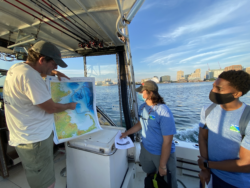
Photo Credit: Kristen Barry
The biggest surprise of the day came when a leatherback sea turtle surfaced next to the boat halfway up the bank. A turtle sighting is often a fleeting wish of visitors to the bank, due to the fact that their trips to the surface are not as magnificent as those of the whales that we saw. This amazing spot by Krill seemed to be consuming a jellyfish, and we only had a few short moments to observe its behaviors before it launched itself back into the depths of the water.
As we departed the southwest corner of the bank in our trek back to Boston, Krill pulled out the phytoplankton net for us to get to take a look at the organisms that form the base of the food chain that supports all of the fish, whales, seals, and seabirds offshore. We dragged the net for five minutes and upon pulling it back into the boat, we could see all of the microorganisms that were trapped inside. Krill had us take a closer look utilizing the magnifiers, and we were able to see the phytoplankton dancing around the slide. These are truly the species that you don’t typically think about when visiting the National Marine Sanctuary, and we were so excited to be able to interact with these organisms.
We were truly impressed with all of the ways that the Fishbucket was being cognizant of conservation during our travels. We learned that some people use balloons in their pursuit of larger fish, and often these balloons are found floating in the waters. Not only did we stop for every balloon that we saw to scoop it out of the water and place it in the trash aboard, but we stopped for any foreign objects, such as plastic, that we encountered along the way. That being said, for the most part the sanctuary proved to be a very clean area, presumably due to the respect of visitors and admirers of the Stellwagen Bank.
While any day spent on the water is a good day, this one was unbelievable. We were able to learn so much more about the waters that neighbor the harbor that we interact with on a daily basis, not to mention see a ton of amazing creatures and catch a ton of fish. Thanks to Captain Mike and first mate Bradley, we were all able to take home heaps of fish which we all promptly took home and cooked for dinner!
We are so grateful for the opportunity to be a part of such an amazing and enriching trip, and would like to thank the National Marine Sanctuary Foundation for the chance to learn more about the unique features of the Sanctuary and the species that live there. We would also like to thank Captain Mike Delzingo of Fishbucket Sportfishing Charters Boston for connecting us with this full day of offshore exploration through a lens of conservation, allowing us to go beyond fishing in the Boston Harbor and interact with more species in the Massachusetts Bay. The day would not be the same without our resident expert Krill Carson from New England Coastal Wildlife Alliance who not only told us the specific names of each of the whales that we saw but served as our personal encyclopedia on all things Stellwagen Bank. It truly was an unforgettable experience that we all cannot stop talking about and sharing photos and videos from! We hope to be able to have a similar experience to share with our other youth program staffers in the years to come!
Until Next Time,
Michael Dello Russo, Revere
Grace Burns, Brighton
Roy Thompson, Dorchester
Vanessa DoVale, Dorchester
Kristen Barry, Cambridge
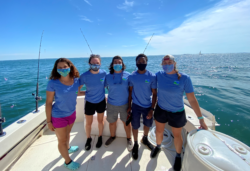
Photo Credit: Kristen Barry
